Piment d'Espelette
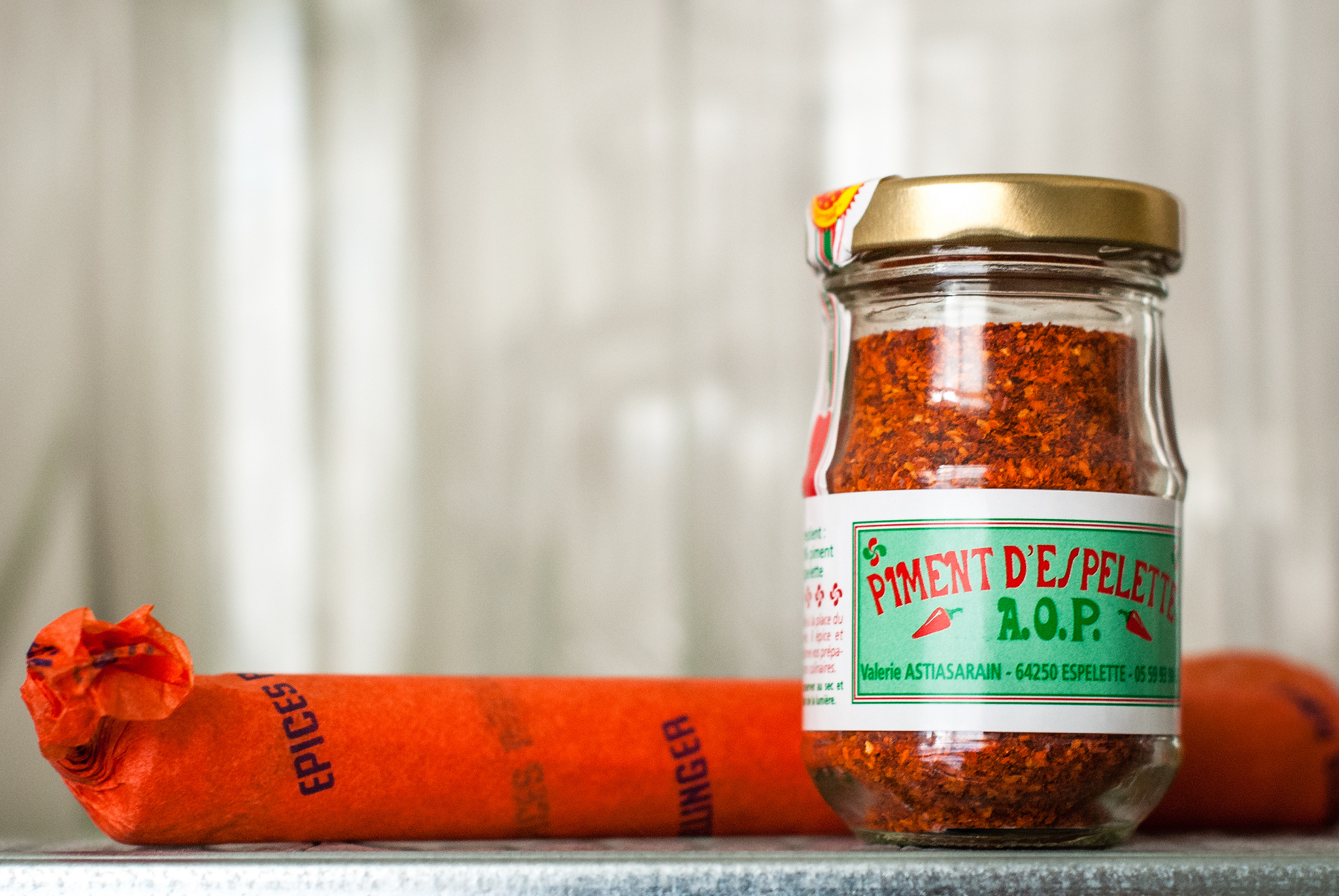
Image: Stijn Nieuwendijk via Flickr
We’re in our boss’ kitchen, which is tidy and taupe in the way I’d only ever seen in a Martha Stewart Living, my mom’s copy, the one she checked out from the library.
We’re cooking all day, like I’m told we do every Tuesday. The kitchen is a busy, steaming, full-team operation crammed into a space meant for Sunday pie-making with kids. I learn quickly to watch for limbs, stray utensils, aproned bodies. This is my first week—my second day—at a food start-up in New York. My second day of moving past the casseroles and the piles of peas I came from.
Someone asks me to grab the Piment d’Espelette and I nod and smile and say “of course!” even though I have no idea what that is—whether it’s animal, or mineral, or some fancy antique baking mold from the French Revolution. I look around, for what I don’t know: understanding eyes? An early Alexa prototype? There doesn’t seem to be time to fall back on the methodology that got me through yesterday: Quickly Google the fragments of sounds I think I heard (“pee-mon dESS-plett”) then make an informed decision from the top three hits. I open the drawer closest to me. It’s the spices, a lucky guess.
Achiote
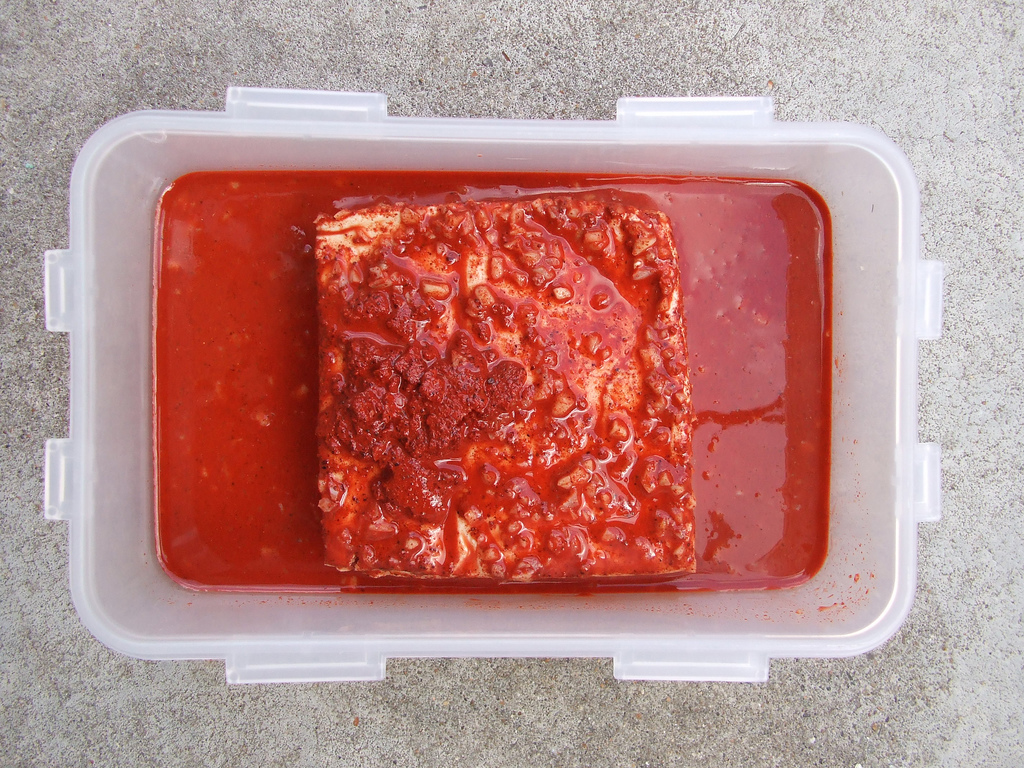
Image: Denna Jones via Flickr
As a kid in Texas, I spent most afternoons at my neighbor’s house—she was an elderly Spanish woman, she’d moved from Madrid for her own children—and after I’d annoyed her into oblivion for the whereabouts of her grandson, she’d sit me at her daughter’s table and cook me a meal. She made soups and queso frito. She rolled tortillas and empanadas. Sometimes she’d sit and watch me burn my lips on all them. But other days, she’d bring me clips of last night’s dinner, plastic plates of curried goat, or searing empanadas; but every now and again she’d lather her dishes with a powder, a smoky blend of spices that turned out to be achiote.
Achiote is the same thing as annatto but sometimes people confuse the two. Annatto seeds are ground for achiote paste, and that’s blended with other spices to serve as a rub. It gives your food this orange-ish color. Or a yellow-ish one. Or a pulsing red. The seeds are extracted from Bixa orellana, which lives and dies in tropical climates, and if you’ve spent time in Latin America or the Caribbean or the southwest States, then you’ve seen it dashed somewhere across your plate.
Robert David & Adrian Diaconu, "Bacterial Motion (Edit One)"
Be thankful it’s almost over. Enjoy.
New York City, November 21, 2017
 ★★★★ The river was inky and almost nonreflective, but so much sun shone on a building on the far shore that it cast a butter-colored gleam on the dull water regardless. Brilliant paper-white gulls rose and dipped in the distance against the gray. One plane tree by the schoolyard was drenched with gold in the otherwise color-parched autumn. In late morning, the clouds, stretching up in winglets, took on a ruddy sundown tinge. After that, the light became wholesome again. It was time again to worry about the ambient cold getting into the phone and sapping the battery. The night was so clear and it fell so early that, on the walk home with chicken for dinner, all three points of Summer Triangle could be found in the sky.
★★★★ The river was inky and almost nonreflective, but so much sun shone on a building on the far shore that it cast a butter-colored gleam on the dull water regardless. Brilliant paper-white gulls rose and dipped in the distance against the gray. One plane tree by the schoolyard was drenched with gold in the otherwise color-parched autumn. In late morning, the clouds, stretching up in winglets, took on a ruddy sundown tinge. After that, the light became wholesome again. It was time again to worry about the ambient cold getting into the phone and sapping the battery. The night was so clear and it fell so early that, on the walk home with chicken for dinner, all three points of Summer Triangle could be found in the sky.
Soda With Bitters

Image: Farther Along via Flickr
Last winter, I embarked on my first Drynuary with a mix of shock and self-righteousness. I was thirty-fucking-five years old and I seriously, SERIOUSLY, couldn’t remember going an entire month without drinking. By Day 5, my husband told me, I started reminding him of the straight-edge kids from high school. But, I was really onto something. Wasn’t it crazy that we configured our lives around the consumption of alcohol, the same way that we configured our living rooms around television sets? Wasn’t it odd that we were always a little inebriated around friends and coworkers? How could we tell who we really were if we spent so much time in an altered state? He suggested I listen to some Youth of Today and opened a beer.
Even though I wasn’t drinking, I was determined to keep up with my social obligations, which meant I often found myself in bars, explaining to people that I had sworn off booze for the month. Around Day 12, I found myself in that particular circle of hell known as Hotbird on a Friday night. It was here that my friend Nadja introduced me to her coping mechanism for her own Drynuary: seltzer with a dash of bitters.(Bitters are also 44.7 percent alcohol, so a dash is either technically disqualifying for the “dry” part of Drynuary, or a symbolic way of partaking without partaking. It’s between you and your Oprah.) The idea was, she explained, was to, more or less, fool yourself by ordering a signature cocktail, which conferred a sense of agency, rather than a sense of deprivation. It was quirky, it was refreshing, and it was delicious.
Tarragon
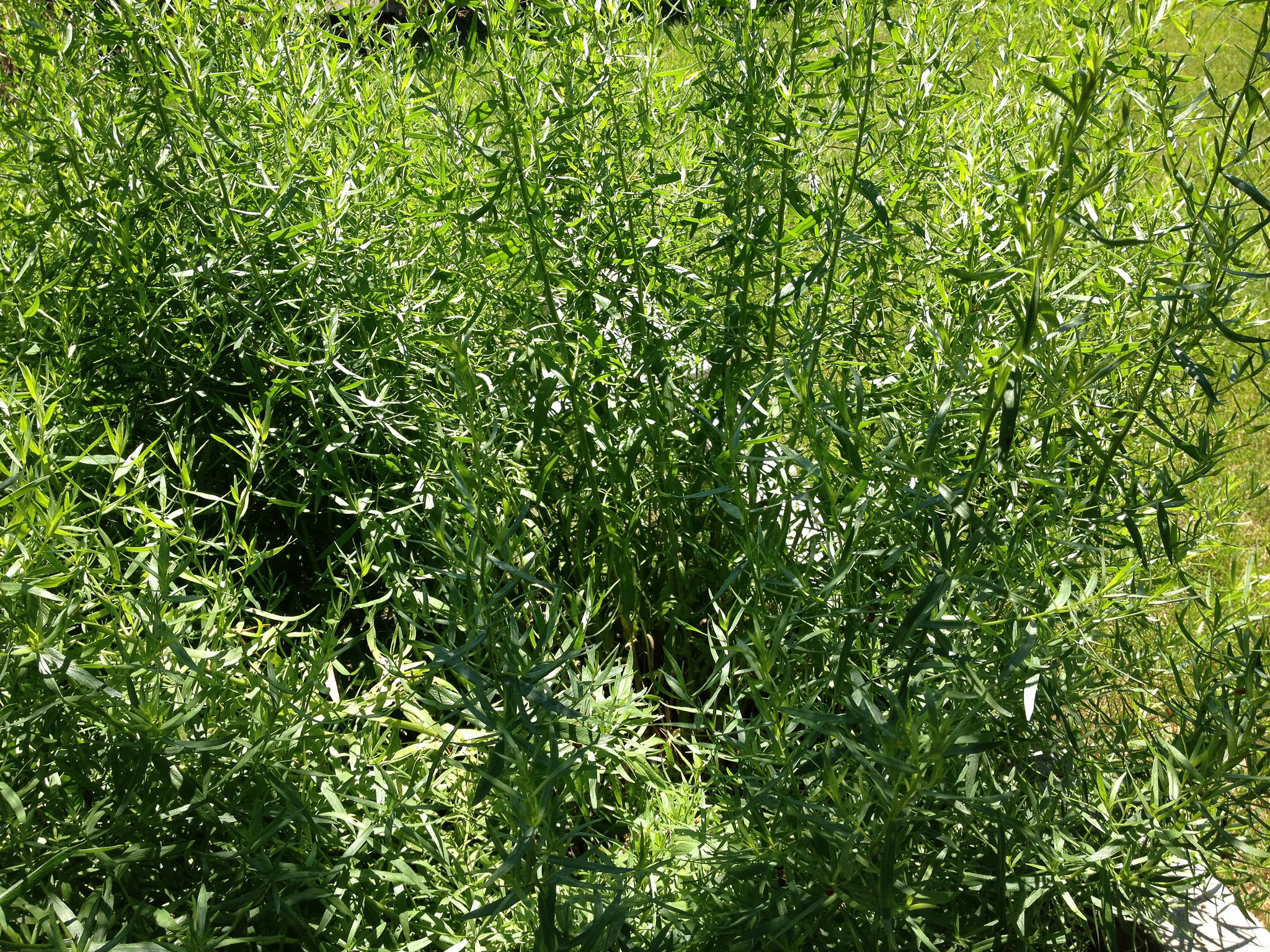
Image: Blaine Horrocks via Flickr
My mother and grandmother weren’t the types to use “recipes” very often, and, once they were both dead, and I was visiting my aunt, I was surprised when she pulled out a giant box of cards, notebooks, and loose sheets of lined paper covered in both of their distinctive scrawls.
This wasn’t my mother’s mother, but her mother-in-law. My own mother’s mom wasn’t really a cook, but my mother found a food buddy in my grandma Elly. They cooked the same way: by gut, never fussy, always talking the whole time. They could put together meals while doing other things, while managing children or talking on the phone.
At the time I took this box full of never-organized scraps home with me, I’d been cooking in earnest for maybe a decade. But I hadn’t inherited these women’s casual, throw-whatever-together-it-will-definitely-work approach. In order to do that, to become that type of cook, I assume, you have to spend a lot of time in the kitchen actually doing the method, watching another do it. But I’d been away from my mother since I was a teenager, and so, I learned to cook the only way I knew how: from a book.
A Taxonomy Of Spices Based On Three Million Instacart Orders
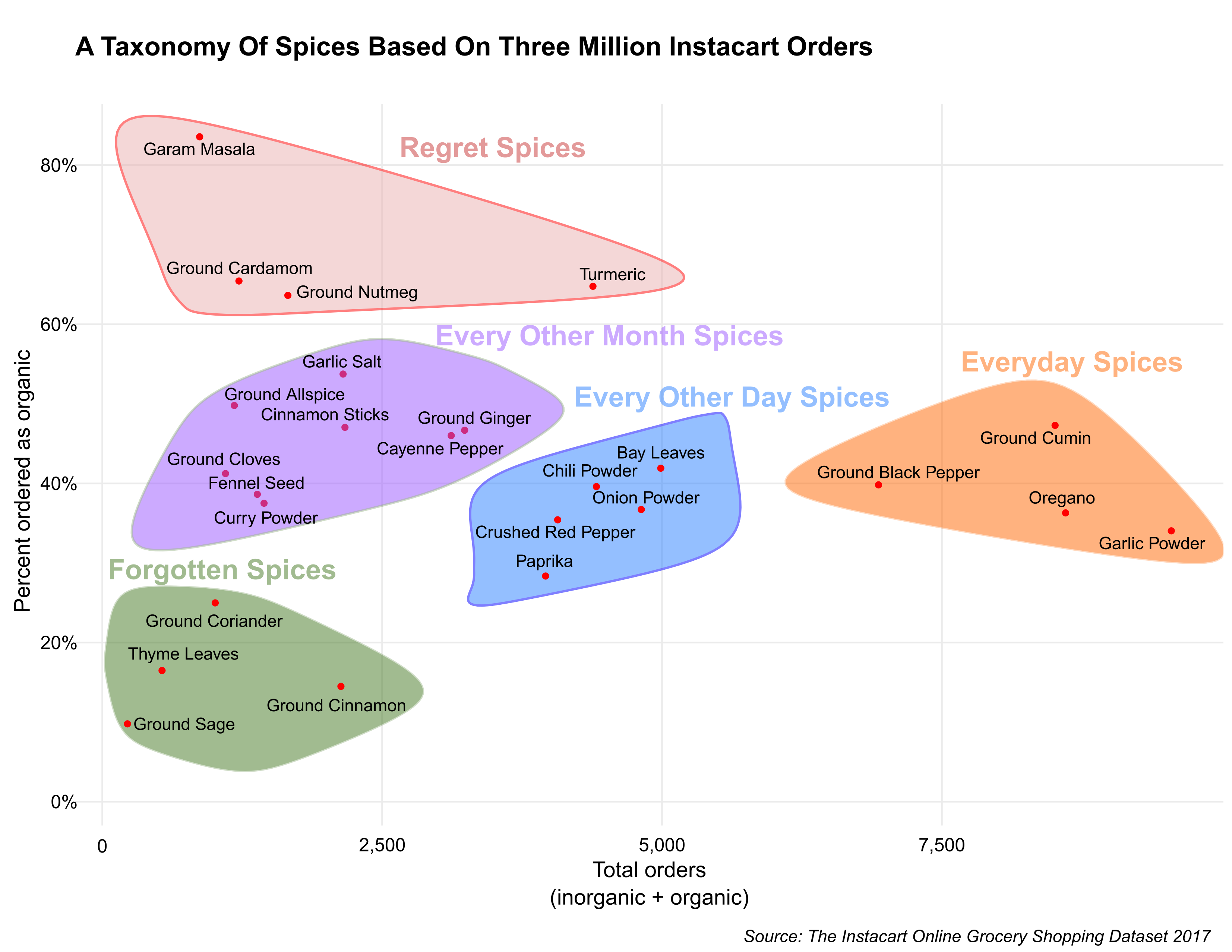
Earlier this summer, Jeremy Stanley, the Vice President of Data Science at Instacart, made the data on three million Instacart orders available for anyone to look at. Stanley wrote in a Medium post that he hoped people would use the data “to test models for predicting products that a user will buy again, try for the first time or add to cart next during a session.” Stanley should have known though that the data would ultimately be used to find out when shoppers purchase condoms rather than to develop some breakthrough recommendation algorithm.
The data includes the names of products and the aisles those products are found in at the grocery store. For example, 797 different items from the spice aisle have been purchased at least once on Instacart.
Above is a chart that looks at how many times the most common spices have been ordered (the inorganic and organic versions combined) versus the proportion of those orders that are for the organic version*. By looking at the chart we can see that that the most ordered spice on Instacart is garlic powder with 9,549 orders and of those orders 34 percent are for the organic version. Compare that to garam masala, which has far fewer total orders (870), but a much higher organic order rate (84 percent).
Germans Do Not Have a Word For Cilantro Because They Hate It
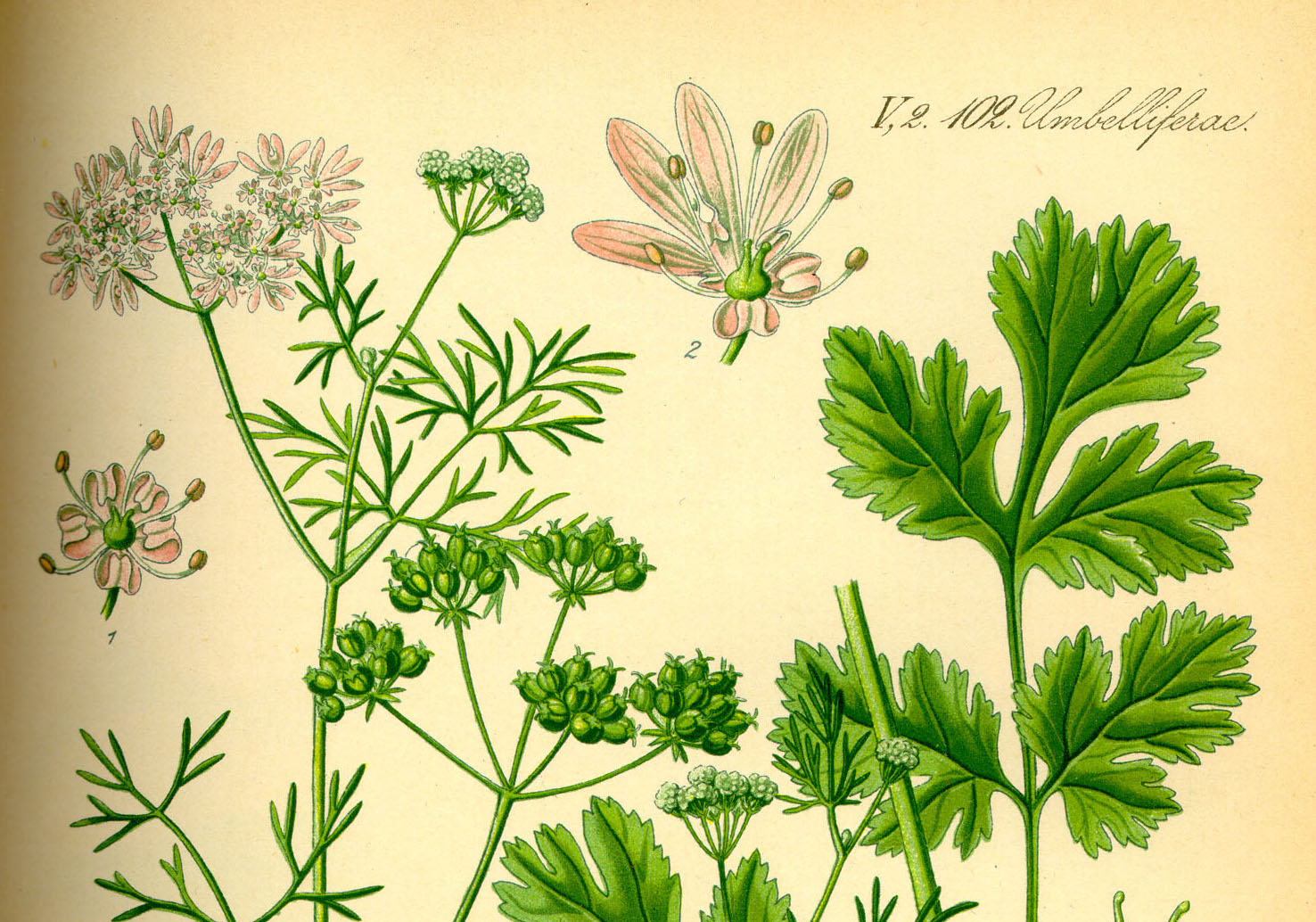
“Real Coriander,” as Germans call it, because they are wrong. Image: public domain
A few years ago (fine, it was almost eight years ago, because time really is a flat circle and I am a jabillion years old), the New York Times ran a very widely read story about a very polarizing herb. Lo, the Grey Lady came bearing excellent news for the outspoken loathers of a certain bright green that makes Latin American and Asian dishes jump off the plate: “Cilantro haters,” She intoned, “it’s not your fault.” Apparently, some people (not me) are genetically hard-wired to associate the smell of cilantro with bedbugs or soap.
These people are predominantly ethnic Europeans such as myself (clearly, I was spared). And among those are Germans, to whom Many Americans in the mid-20th Century referred as Krauts, after sauerkraut, the ubiquitous side dish made of fermented cabbage that is, so far as I can discern, the only thing that makes it possible for any German to shit.
Kraut (KROWT!) means cabbage, yes—but it also means “herb” in general. The plural is Kräuter (KROY-tur), and in traditional German cuisine, it usually refers to one or more of the following: thyme (Thymian, TOOM-ee-un), marjoram (which I can’t even pronounce in English), parsley (Petersilie, PEH-tur-ZEE-LEE-uh, which we will talk about more in a second, oh don’t you worry), bay leaves (Lorbeerblätter, LORE-beah-BLEEEEHT-uh), caraway (Kümmel, KOOOM-l), and so, so, so, so fucking much dill (der Dill, ha ha).
Why My Parents Eat Paprika On Cottage Cheese

Image via Cardboard America
For as long as I can remember, my parents have eaten cottage cheese with paprika on it. This is… weird? No one else I know does this, at the very least. It’s a traditional Hungarian way of eating it, but we are not a Hungarian family. For this piece, I did two big things: first, I interviewed my parents to figure out why the heck this tradition exists in my family and second, I tried paprika on cottage cheese (my review? It’s fine).
![]()
Me: How ya doing?
Dad: I. Am. Good.
Mom: I don’t know what he’s doing. We’re good.
Dad: She’s. Transcribing.
Me: I’m using a recorder, so you can talk normally.
Dad: O.K.
Mom: Oh boy
Me: So I’ll just preface this and say this is an interview with my parents, okay?
Dad: Yes.
Mom: [laughing in the background]
Me: The Awl is doing a series of pieces on spices, and the best I could come up with, because we’re not an aggressively spice-heavy family, is that you both do a thing where you eat cottage cheese with paprika on it. I wanna know why the heck that is.
Tasting The Devil

Photo via Wikimedia Commons.
The “ouzo effect,” or “louche effect,” takes place when you pour water into one of the aniseed boozes. These are raki, pastis, ouzo, absinthe, arak, and sambuca. The liqueur begins clear or slightly colored (green, in absinthe’s case) but upon contact with water it turns a milky white as if transmogrified into the semen of the devil. This phenomenon occurs because the essential oil trans-anethole, also known as the flavoring compound anise camphor, is strongly hydrophobic: the oil has been dissolved in alcohol but when water is introduced it freaks out, turning the liquid opaque.
The association between aniseed and opacity feels spiritually right, because the merest whisper of aniseed on the air turns my world into a black void composed entirely of disgust. It is a total phobia. Trans-anethole is essentially what we know as anise, but it also gives that characteristic flavor to fennel, licorice, camphor, magnolia blossoms, and star anise. Fennel in a salad? No. The German candy Pfeffernusse? Fuck you. Licorice mixed in with normal candy? Cut my throat, rather.
